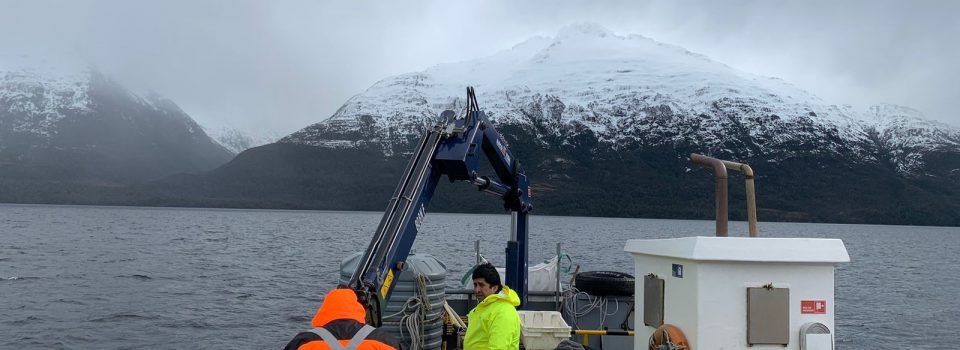Finalización de actividades de terreno campaña 2023 Proyecto Desempeño Ambiental de la Acuicultura en Chile y sus efectos en los ecosistemas de emplazamiento
septiembre 26th, 2023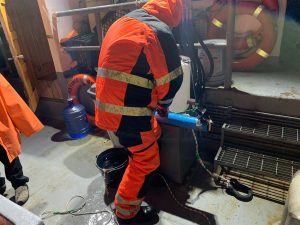 Dentro del marco del proyecto del Desempeño Ambiental de la Acuicultura en Chile y sus Impactos en los Ecosistemas de Emplazamiento, proyecto perteneciente al Departamento de Medio Ambiente con sede en Puerto Montt, se llevó a cabo la última parte de las actividades de terreno correspondientes al área comprendida de Golfo Almirante Montt, ubicado en la Comuna de Natales, Región de Magallanes.
Dentro del marco del proyecto del Desempeño Ambiental de la Acuicultura en Chile y sus Impactos en los Ecosistemas de Emplazamiento, proyecto perteneciente al Departamento de Medio Ambiente con sede en Puerto Montt, se llevó a cabo la última parte de las actividades de terreno correspondientes al área comprendida de Golfo Almirante Montt, ubicado en la Comuna de Natales, Región de Magallanes.
En esta ocasión, por primera vez los equipos del proyecto del desempeño ambiental y oceanografía (proyecto “Monitoreo y Modelación de la Variabilidad Espacial y Temporal de Procesos Oceanográficos en Canales y Fiordos Australes”) de la sede Putemún, Chiloé, se unieron en la realización de este muestreo. Juntos llevaron a cabo actividades de apoyo y operaciones en la cubierta de la embarcación. Este equipo estuvo compuesto por los biólogos marinos Johana Ojeda y Rodrigo Jaramillo, así como por la oceanógrafa Marcela Toro y el asistente técnico Miguel Vergara. Además, en las operaciones de cubierta se contó con la colaboración de 3 miembros de la tripulación del L/M “Don Antonio” de 34 TRG.
Descripción del Área de Golfo Almirante Montt
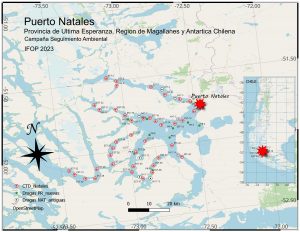 El sistema de canales del Golfo Almirante Montt, que se extiende de oeste a este a lo largo de aproximadamente 15 millas marinas, presenta su menor ancho en dirección norte-sur, con una distancia de 4 millas. En este sistema convergen cuatro esteros importantes, los cuales desempeñan un papel fundamental en la configuración y dinámica de esta región costera. Estos esteros son:
El sistema de canales del Golfo Almirante Montt, que se extiende de oeste a este a lo largo de aproximadamente 15 millas marinas, presenta su menor ancho en dirección norte-sur, con una distancia de 4 millas. En este sistema convergen cuatro esteros importantes, los cuales desempeñan un papel fundamental en la configuración y dinámica de esta región costera. Estos esteros son:
Estero Última Esperanza: Ubicado al noreste, es uno de los esteros más notables que se unen al Golfo Almirante Montt. Su nombre evoca un sentido de misterio y exploración, lo cual se debe a su rica historia y su importancia en la navegación y el comercio de la región.
Estero Obstrucción: En el lado sur del golfo, el estero Obstrucción se entrelaza con el sistema de canales. Su nombre sugiere la naturaleza intrincada de esta zona, que históricamente presentaba desafíos para la navegación debido a su compleja geografía.
Estero Poca Esperanza y Canal Valdés: Situado al suroeste, el estero Poca Esperanza se conecta con el Golfo Almirante Montt a través del canal Valdés. Esta interconexión entre estero y canal añade una dimensión única a la dinámica del área, influyendo en el intercambio de aguas y nutrientes.
Estero Worsley: Al noroeste del golfo se encuentra el estero Worsley, que contribuye al flujo de agua y nutrientes en esta región. Su proximidad al mar y su papel en la ecología local hacen que sea un punto focal importante para la investigación científica.
Canal Kirke: La navegación por este canal-angostura que comunica el área de los canales con las aguas provenientes del océano pacífico, es de navegación desafiante y técnica debido a las mareas y las corrientes las cuales se estiman en alcanzan normalmente de 8 a 10 nudos de intensidad máxima. Cabe recordar que el nombre de este canal proviene de las primeras prospecciones oceanográficas realizadas en la zona por el Capitán británico Pringle Stokes en la embarcación Beagle.
Actividades del crucero
En esta ocasión, se llevó a cabo un recorrido que abarcó muestreos en 38 puntos con equipo CTD y 19 puntos de recolección de muestras de sedimentos utilizando draga van Veen. Estos muestreos son esenciales para comprender la dinámica química y biológica del área, así como para evaluar la salud del ecosistema marino. De manera significativa, se dedicaron 11 puntos específicos a la prospección de sedimentos, con el propósito de explorar áreas previamente menos estudiadas. También se realizó la inspección de la estación meteorológica instalada en la zona de Puerto Natales, la cual entrega información en línea para el proyecto Chonos.
Estas acciones se realizaron en cumplimiento de los objetivos de ambos proyectos, que tienen como uno de sus enfoques principales el seguimiento de la variabilidad estacional de las condiciones químico-biológicas en el Golfo Almirante Montt. Las variables monitoreadas, como la temperatura, salinidad, oxígeno disuelto, concentración de nutrientes, identificación de la macrofauna y otros parámetros, brindan una visión integral de los cambios que ocurren en el ecosistema marino.
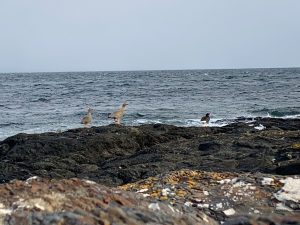 En toda el área de movimientos terrestre y marítimo se realizaron observaciones de mamíferos y aves patagónicos tales como: guanacos (Lama guanicoe), ñandúes (Rhea pennata), caiquenes (Chloephaga picta), zorros (Lycalopex culpaeus), armadillos (Chaetophractus villosus), flamencos (Phoenicopterus chilensis), mofeta patagónica (Conepatus humboldtii), cóndores (Vultur gryphus), patos quetros (Tachyeres pteneres), delfines australes (Lagenorhynchus australis), pingüinos de Magallanes (Spheniscus magellanicus), carancas (Chloephaga hybrida), cormoranes (Phalacrocorax magellanicus y Phalacrocorax brasilianus), gaviotín sudamericano (Sterna hirundinacea) y gaviotas.
En toda el área de movimientos terrestre y marítimo se realizaron observaciones de mamíferos y aves patagónicos tales como: guanacos (Lama guanicoe), ñandúes (Rhea pennata), caiquenes (Chloephaga picta), zorros (Lycalopex culpaeus), armadillos (Chaetophractus villosus), flamencos (Phoenicopterus chilensis), mofeta patagónica (Conepatus humboldtii), cóndores (Vultur gryphus), patos quetros (Tachyeres pteneres), delfines australes (Lagenorhynchus australis), pingüinos de Magallanes (Spheniscus magellanicus), carancas (Chloephaga hybrida), cormoranes (Phalacrocorax magellanicus y Phalacrocorax brasilianus), gaviotín sudamericano (Sterna hirundinacea) y gaviotas.
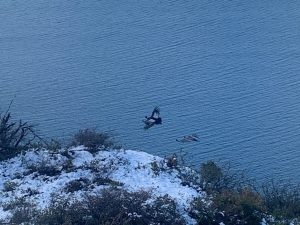 A pesar de las variabilidades climáticas inherentes a la zona y a los desafíos que presenta el entorno marino, las actividades se llevaron a cabo según lo planeado, dentro del marco de la seguridad en la navegación, concluyendo exitosamente. Esto aportará valiosa información para la comprensión y conservación de este importante ecosistema costero.
A pesar de las variabilidades climáticas inherentes a la zona y a los desafíos que presenta el entorno marino, las actividades se llevaron a cabo según lo planeado, dentro del marco de la seguridad en la navegación, concluyendo exitosamente. Esto aportará valiosa información para la comprensión y conservación de este importante ecosistema costero.
